Condos were whacked hardest again last month, at least as measured by the size-adjusted median price. That price indicator was down 6.4% for condos between January and February alone. The detached home size-adjusted median was down 3.0%, with a volume-weighted aggregate of the two down 3.8%.
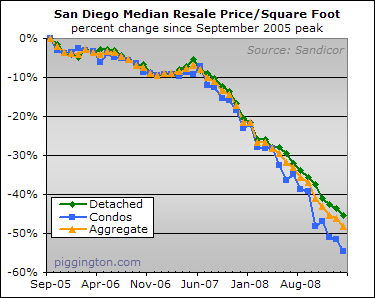
From the September 2005 peak of the series to last month, the size-adjusted median price was down 45.3% for single family homes, 54.5% for condos, and 48.3% in aggregate.
I wrote a bit about the potential distortion caused by the rush to cheaper inventory over at voiceofsandiego.org… due to my abject laziness, I will excerpt it here:
The well-documented shift in buyer preference towards lower-priced homes is causing these numbers to overstate the total price decline. But not by a whole lot. We can try to assess the impact of the shift towards cheaper properties by comparing the size-adjusted median price to the Case-Shiller index, which measures subsequent sales of individual single-family homes and is thus a much more accurate price measure.
The Case-Shiller index was most recently update for December, at which time it showed a 39.2 percent decline from the peak. Because the index is based on sales taking place in the previous three months (October, November, and December, in this case), the December index number actually best represents November pricing.
Thus, we should compare the December Case-Shiller index reading to the November size-adjusted median price. As of November, the size-adjusted median for single family homes had declined by 41.1 percent from the peak — 1.9 percent more than the Case Shiller index.
So the green line in the accompanying chart does overstate actual detached home price declines, but only to a very small degree in the grand scheme of things.
Since the Case-Shiller index doesn’t measure condo prices the same comparison can’t be performed for that property type. This is too bad, because the substantially larger decline in the size-adjusted condo median leads one to wonder whether there is some greater distortion in the median-based condo price indicators — or whether the condo market has indeed been spanked that much harder.
In any case, here’s a gander at the plain vanilla median, where the disparity between condos and detached homes is even bigger:
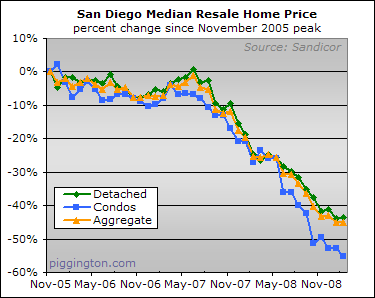
And here is my projected decline in the Case-Shiller index, based on the detached home size-adjusted median. Bear in mind that due to the distortions discussed in the Voice excerpt above, this projection method has recently tended to predict a bigger decline in the Case-Shiller index than actually ended up happening.

Sales volume was good again, down for the month in what seems to be a typical seasonal pattern, but still higher than either of the past two years.
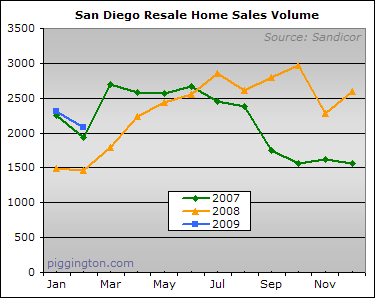
Interestingly, volume has increased a lot more for single family homes than for condos. The following chart shows the year-over-year change for each month since Feb 2008. While both property types have improved on a year-over-year basis, the improvement has been dramatically higher for detached homes (and this has been the case since mid-2008).
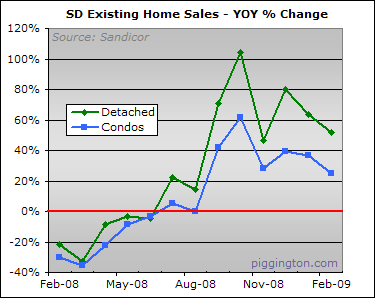
Inventory rose a bit — also seasonal — but was lower than at any time during the prior two years:
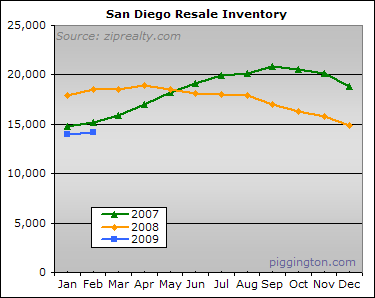
As you’d expect given the above, the months of inventory figure also put in a good showing:

Of course, the low months of inventory hasn’t been a great indicator on account of that whole foreclosure onslaught/economic meltdown thingy. February marked an all-time high for mortgage default notices — but I will do a dedicated post on that soon.
Still, the one bright spot is that sales activity continues to hang in there. Given all the people either being laid off or in fear of being laid off, that’s kind of impressive. It will be interesting to see if we get the traditional surge in March. If so, then that market definitely has that buyer interest going for it. But there’s plenty going against it too — and all the sales activity is still not yet enough to stop the price decline.

Thanks Rich. Dont you also
Thanks Rich. Dont you also track sales volume by price level? Not sure for SD, but CA in general is seeing most of the sales volume at $350K and below.
It would be nice if CSI could use Zip codes.
I also wonder if SD has 12% of all its mortgages now in late payment status? And 20% of all its mortgages upside down, per the national numbers.
peterb wrote:Thanks Rich.
[quote=peterb]Thanks Rich. Dont you also track sales volume by price level? Not sure for SD, but CA in general is seeing most of the sales volume at $350K and below.
It would be nice if CSI could use Zip codes.
I also wonder if SD has 12% of all its mortgages now in late payment status? And 20% of all its mortgages upside down, per the national numbers.[/quote]
Hi Peter — Yes, here is the latest comparison between per-zip code sales and prices:
http://www.voiceofsandiego.org/articles/2009/02/20/toscano/734jansalesbyzip022009.txt
No question that the surge in activity is centered at the low end. Even still, given the environment I think it’s notable that volume hanging in there, even if it is favoring the cheep places.
Re. your other point about the CS index, check out esmith’s blog at http://sdhpi.blogspot.com — he has recreated the CS methodology and applied it at the zip code level.
Rich
Oops, forgot your last
Oops, forgot your last question… per the Voice, over 30% of SD mortgages were under water in Dec 08, so that’s going to be a bit worse now:
http://voiceofsandiego.org/articles/2009/03/12/survival/310underwater031109.txt
Rich
Sales are always down in
Sales are always down in February…fewer days.
As much as inventory looks lower than the previous two years it is greatly overstated. I would estimate that at least 20 to 30% of the active inventory is short sales with offers already submitted to the lenders.
sdrealtor wrote:Sales are
[quote=sdrealtor]Sales are always down in February…fewer days.
[/quote]
Good point. 🙂
[quote=sdrealtor]
As much as inventory looks lower than the previous two years it is greatly overstated. I would estimate that at least 20 to 30% of the active inventory is short sales with offers already submitted to the lenders.
[/quote]
Interesting… what % do you think were in that state (short sales listed active but w/offers submitted) last year?
Rich
Bring data.
Bring data.
Whether a month has a few
Whether a month has a few more or less days is not a controlling factor in volume.Variations far exceed the range such a factor would allow for if it were dominant. Seasonality tends to have more effects, but even this gets blown away by other factors at times.
Gotta agree with sdr on this
Gotta agree with sdr on this one … Feb has 10% less days than Jan, this is significant enough to cause a drop in monthly volume.
The biggest point is the
The biggest point is the short sale statement.
I cannot understate how many of the active listings that are short sales are not really active. I would estimate at least 50% have offers and are either only taking backups or are pretty much taking up space until they hear back from the lender. Forget about the fact that the buyer may indeed back out and then they become true actives again. These really should be parsed out so that people can see the very real “active” inventory. Then once the listing agent hears back from the lender the property can go pending or it can become a real “active” again if the buyer has walked.
EJ, It could have caused the
EJ, It could have caused the drop but it is not known to have caused the drop.It doesn’t “always” happen according to the number of days in successive months. Look at the chart above,” San Diego Resale Home Sales Volume”. It shows that volume can and does change drastically even in successive months with the same number of days or when the difference is only 1 day. So it is a factor but there are also others that could have been in favor of making Feb. stronger than January that did not prevail.
The short sale issue is nothing new. For the most part short sales earlier on were nearly hopeless so this is questionable as to being a significant factor in decreasing effective inventory.Many of these are not going to close even if they have “accepted” offers. It seems like we can’t assume that inventory is reduced by a factor of 30% compared to recent times for many reasons.
No it is not a correct
No it is not a correct statement to say that it does not decrease inventory.
Your client wants to go see a home and/or put an offer on it. You call the listing agent and the listing agent says, “you can either submit a backup offer, or we are not accepting any offers at this time.” This home then is not an active. Your client has one less home to choose from. This does reduce the inventory. This has stymied alot of my clients recently.
How about this, I challenge you to pick up the phone and call on some of these short sales and tell me what you find out. Pick say 10 or 20 of them and call on them. See what they say and come back with a percentage. The number I came up with is based on my experience because I have been doing nothing but calling on them for my clients.
Now I do indeed agree that many of them will not close for whatever reasons. Yet that still does not make them an active listing. If you cannot make an offer that will find it’s way to the lender then how can you consider that an active listing? They are not really active in the true sense of the word. They should not be marketted or considered active and they should be either in withdrawn or some to be created status.
Also I have a short sale that is closing in about 2 weeks and another was closed in November. I don’t feel they are hopeless but yes they are challenging.
Rich
Last year they were
Rich
Last year they were neglible until the later half of the year at best. To put this into perspective, I’ve got about 10 short sale listings that show as active in Sandicor. 8 have offers and most have multiple offers. One that doesnt is new and the other is a mystery to me as to why it doesnt. Of the homes with offers, there is one that’s a longshot to close for reasons i cant get into but the others should easily. I got 5 new ones coming on in the next week or two. All of them are very sellable, will sit active for a couple months with multiple offers, be approved, go pending and evenetually sell to one of the buyers.
Russell
With all due respect, SD R and I are much more active in what is going on out there. How often do they let you out of Jamul anyway?;)
Last year they were neglible
Last year they were neglible until the later half of the year at best. To put this into perspective, I’ve got about 10 short sale listings that show as active in Sandicor. 8 have offers and most have multiple offers. One that doesnt is new and the other is a mystery to me as to why it doesnt. Of the homes with offers, there is one that’s a longshot to close for reasons i cant get into but the others should easily. I got 5 new ones coming on in the next week or two. All of them are very sellable, will sit active for a couple months with multiple offers, be approved, go pending and evenetually sell to one of the buyers.
Russell
With all due respect, SD R and I are much more active in what is going on out there. How often do they let you out of Jamul anyway?;)[/quote]
Amazing how easily you transition from anectdote to ad hominem,respect ;).Lather, rinse, repeat ;).
Russ
Dont know if that was
Russ
Dont know if that was serious or a jab but either are fine. I spend so much time thinking about these things. I find that whenever I take the time to pull out a slide rule and test my perceived beliefs my figures are very close to what I end up calculating. A bit of confirmation bias? Perhaps, but I dont make wild eyed guesses. The numbers I use anecdotally are based on considerable thought.
The only numbers I use that I would cast a sideways glance at are driving distances. To me any thing close is 5 minutes away whether it is 5 or 15 minutes. Drove my wife crazy but I’d bet lots of guys do this too.
sdr
20% to 30% in short sale
20% to 30% in short sale process seems like a huge statement to make about the whole county. But even if this is accurate, how many close? Short sales are full of reasons to not close. Is there data that shows short sale numbers or is it all by word of mouth? And just because a transaction is “in process” it does not mean it’s not “for sale”…as in actively seeking to sell the property. Active means it’s for sale and has not closed yet. As someone who is looking to sell a house, you may be unmotivated to show the place because it’s in short sale process, that’s a business decision you’re making. It does not mean it is no longer for sale. And, as you know, the short sale is very likely to fall out. The “Pending” status is very unreliable in todays market.
Come on guys, I mean
Come on guys, I mean seriously why is it so hard to comprehend the current situation. I almost feel as if many of you are actually threatened by the reality of the market.
Honestly throwing around terms like “effective inventory” discussing whether a home is not “for sale” or not really doesn’t mean much.
Peter how many buyers are you shopping for right now. Russ how many calls have you made to listings? Look when statistics are taken about active/pending ratios, or any other statistic is made about an active listing there is no designation about what is an effective active listing or not. Try to simplify things a little bit as I did above… You have someone who wants a home, the home is listed as active but is a short sale that is not taking any more offers. This home while active, is effectively not available at that point in time. Period. It doesn’t matter if it is a short sale that doesn’t go through. It does count as an active listing for the stats that Rich or anyone else takes. Yet for THAT MOMENT in time it is not available. You can write up an offer for it and it will not be submitted.
This is not anything that threatens the depreciation trend. Have no fears guys the market will keep going down. However to sit there and make statements based on your speculation rather then you actually being a buyer looking for a home or an agent showing homes for alot of buyers does not legitimize your cause, whatever cause that may be.
It is very simple, inventory is down, and of the inventory that is active and listed as a short sale, a fair percentage of those homes are either not taking offers or are only taking backups. What is the problem with that? Why is that such a hard thing to accept? Why don’t any of you make some calls and run your own data to see?
SD Realtor wrote:Come on
[quote=SD Realtor]Come on guys, I mean seriously why is it so hard to comprehend the current situation. I almost feel as if many of you are actually threatened by the reality of the market.
Honestly throwing around terms like “effective inventory” discussing whether a home is not “for sale” or not really doesn’t mean much.
Peter how many buyers are you shopping for right now. Russ how many calls have you made to listings? Look when statistics are taken about active/pending ratios, or any other statistic is made about an active listing there is no designation about what is an effective active listing or not. Try to simplify things a little bit as I did above… You have someone who wants a home, the home is listed as active but is a short sale that is not taking any more offers. This home while active, is effectively not available at that point in time. Period. It doesn’t matter if it is a short sale that doesn’t go through. It does count as an active listing for the stats that Rich or anyone else takes. Yet for THAT MOMENT in time it is not available. You can write up an offer for it and it will not be submitted.
This is not anything that threatens the depreciation trend. Have no fears guys the market will keep going down. However to sit there and make statements based on your speculation rather then you actually being a buyer looking for a home or an agent showing homes for alot of buyers does not legitimize your cause, whatever cause that may be.
It is very simple, inventory is down, and of the inventory that is active and listed as a short sale, a fair percentage of those homes are either not taking offers or are only taking backups. What is the problem with that? Why is that such a hard thing to accept? Why don’t any of you make some calls and run your own data to see?
[/quote]
?
I did not say it doesn’t
I did not say it doesn’t decrease inventory. I said I think there are many reasons we can not assume it decreases effective inventory relative to other recent factors by a large percentage.Rich asked a question that I believe is rooted in the same idea? A subset of a few listings,like the one you are closing. doesn’t prove anything and Peter’s “bring data” still stands.It is not that the original sdr can’t be right, the commentary is just full of assumptions.
One way to remove the effect
One way to remove the effect of “number of days in a month” would be to normalize the monthly sales volume data with the number of days in the month. This would effectively give average sales per day for each month.
You could even take it another step and normalize by business days to account for holidays.